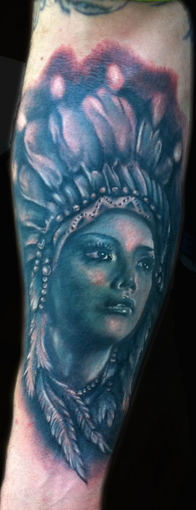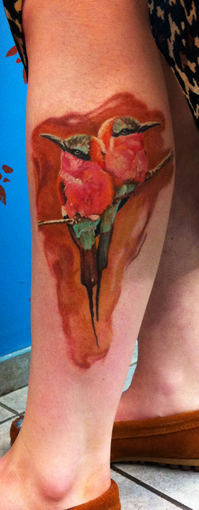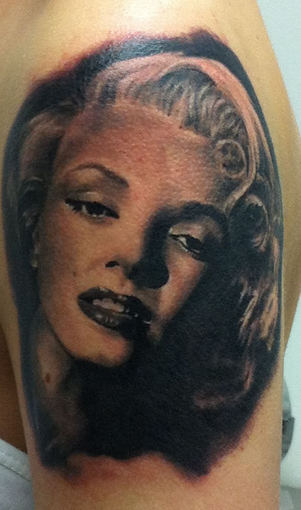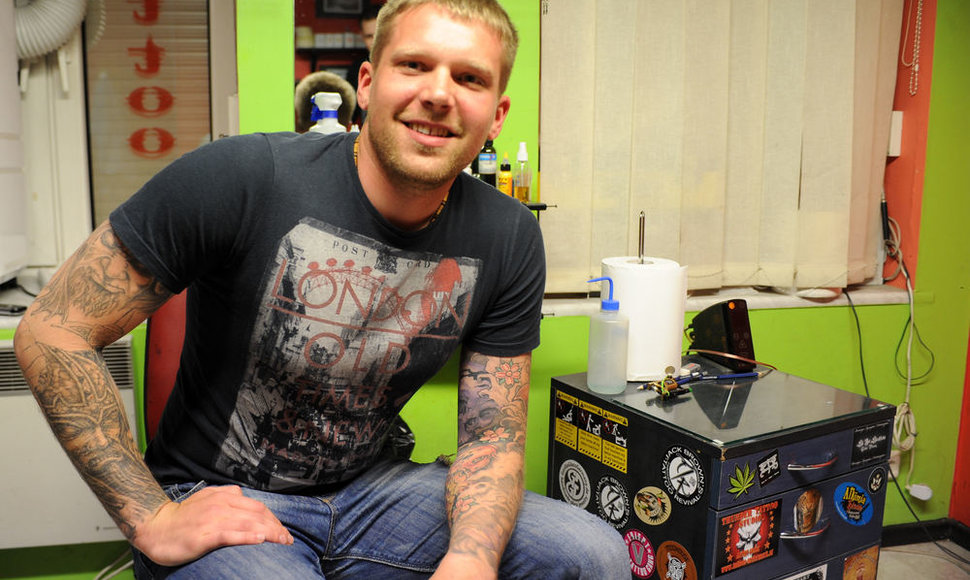The young man has set on making photorealist tattoos the next big thing in Lithuania. There are about ten tattoo artists like him in the entire world.
 |
| Augio Tattoo nuotr./Tatoo (20) |
Augis comes from Telšiai, western Lithuania, from a family of artists. His grandfather, who taught him to draw, is a lecturer at Vilnius Art Academy, his uncle is also a tattoo artist. At 16, Augis became seriously interested in the craft and started reading up on it.
His latest tutor is one of the world's most famous tattoo artists, Dmitri Samohin from Ukraine. Partly thanks to him, people from around the globe are starting to notice Augis.
“Needling” for free
Like many Lithuanians of his generation, Augis found himself working in a factory in Ireland after graduating from school. He wanted to earn enough money to pay for a tattoo salon equipment. It was in Ireland where he got his nickname, Augis Tattoo. His friends would shorten his last name Augulis to Augelis and later Augis. He got so used to it that he started calling himself by the name.
Recalling his first attempts at tattooing now makes him smile. He did it for free at first and was glad to find people willing to let him practise “needling” on them. He had made many mistakes before he polished his skills.
Augis' first job in a tattoo salon was in Denmark. That is where he learned the technique and later moved to Norway. He recently came back to Lithuania – but to Šiauliai, not Vilnius, he finds the capital too big. So far, Augis does not have a salon of his own – there is no point, he says, as people from Lithuania and abroad find him even without a permanent establishment.
Lithuanians drag you down
According to Augis, there are about ten serious photorealist tattoo artists in the entire world. He is the only one in Lithuania and therefore receives a lot of criticism.
“Lithuanians are the kind of people who drag you down instead of giving a boost. You must be very strong psychologically to combat them. I learned to ignore things, just to walk along my path. Some think that tattoos are simple pictures and nothing more. But there's a huge war being waged in the tattoo business. Artists criticize one another. I try to get along with everyone, I do not hold grudge, I've never told anyone that they are doing something wrong,” says Augis.
No mistakes on skin
 |
| Augio Tattoo nuotr./Tatoo (17) |
Augis defines photorealism thus: whatever you can see, you can draw; whatever you can draw, you can tattoo. The range of his designs is wide – from a blossoming flower or bright-coloured bird to a wrinkled old lady or the king of pop Michael Jackson.
At first, Augis practised by duplicating photographs on a piece of paper and then working on skin. “Other people think that such copying is a waste of time. But you just try transferring a 1,000-megapixel image on a piece of paper! You must see hues, shades, depths, distances, blurs, sharpness. Even if you're copying from a photo, you must still know human anatomy. I've studied it a lot – facial wrinkles, expressions, proportions.”
Human skin is not a piece of paper, but similar principles apply in creating images on either. The only difference is that you cannot make mistakes on human skin, Augis says.
A photorealist tattoo is done from bottom up. It is only 50 percent up to the tattoo artist how the finished work will look like. The rest depends on the “canvas”, the type of skin of its bearer. “When I see a healed tattoo, I can tell what the person has been doing and what he or she failed to do. You can even know that, for instance, he was drinking two days before – the skin says is it all,” Augis says.
Tattoo on a 75-year-old lady
Augis' clients are usually people looking for new things. The tattoo artist says he has taken onto himself to show Lithuanians that a tattoo is something more than an ornament, graphic design, or a black spot – it can also be very beautiful. He refuses to tattoo inscriptions or lines, since what he seeks are interesting and challenging tasks.
Women who come to Augis are often into “crazy freaky” tattoos, while men do not shun from flower designs.
The tattoo artist was once commissioned by a 75-year-old woman. “It is complicated to do a tattoo on an old person, but she was unwavering: I don't care what others think, I've seen a lot in my lifetime, I want to do myself up before I die. I did it with great respect,” Augis recalls.
Women more enduring than men
 |
| Augio Tattoo nuotr./Tatoo (1) |
Augis charges for his services by the hour. In Lithuania, one hour of his time costs 150 litas, in other countries – the same figure, except in euros.
He compares the prick of a tattoo needle with a mosquito bite. He says he could stand the pain for 19 hours, yet there are people who surrender within three hours and ask for a longer break. A colour tattoo on a face takes about 6-7 hours, yet if the client cannot tolerate pain, it might take even longer. People usually start showing discomfort within four hours, they get nervous, suffer headaches, can even become feverish. This happens dues to a drop in blood sugar, so the tattoo artist always recommends bringing some chocolate or sweet drinks to recharge one's energy.
Do men cry? “Even the toughest of them. Women are much more enduring than men. Men whine, they're uncomfortable, while women come, sit, go trough it, say “thanks” and that's it,” Augis smiles.
Future abroad
In October, Augis is planning to start working with a famous photorealist artist from across the Atlantic. He has been invited to take part in tattoo festivals in New Zealand and India. Yet he doubts if he is going to India due to his arachnophobia. Augis would love to see Australia too and he could definitely find work there, yet his fear of spiders keeps him away from the southern continent. “I can make a confession – I haven't done a single spider tattoo, even though I've been asked numerous times.”
Ten months ago, Augis received an award for the best female tattoo in Denmark. The audience also chose him as the best tattoo artist. He has made significant progress since, he says.
“When I go and see works by a tattoo artist, I take it all in. When I come back, I feel like I know how to do it. I'm very receptive, I do not need to be told things many times. I had a personal revolution in one festival in Berlin: I met some people, they criticized me a little. One year later, everything had changed, my works were completely different. I learn from every single tattoo, I try to make them more impressive, more detailed, more thorough,” Augis says.
Decoration, passion, and disease
Augis himself sports ten tattoos: on both arms and legs, on his back, shoulder-blades, and one very close to his delicates. “Tattoos are decorations, a way of life. Some people do it in order to look better, sexier, others want to record important moments in their life. Tattoos are a passion and, for some, a disease. People initially plan to have one small tattoo, but then they go for one more, then a bigger one, even bigger, and they end up doing all sorts of silly things. That's why I advise my clients to have a bigger tattoo at once. You can later add more to them, you won't need to hide anything,” Augis suggests.
He admits that tattoos do not look good on wrinkled skin. However, when people inquire him about how he will look like when he grows old, Augis retorts: “I will be a cool grandad, covered with tattoos, completely unlike all the rest.”












